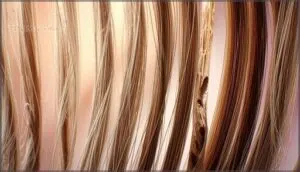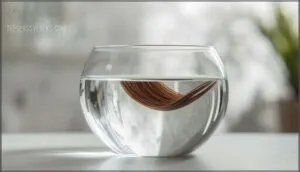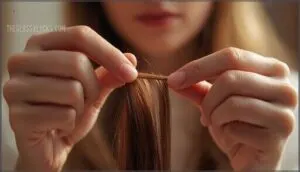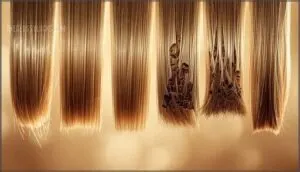This site is supported by our readers. We may earn a commission, at no cost to you, if you purchase through links.
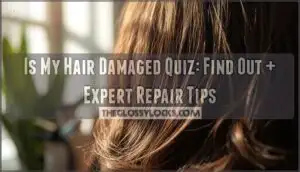 You run your fingers through your hair and feel straw instead of silk—that brittle, breaking sensation that screams damage. Most of us can’t tell if we’re dealing with minor dryness or serious structural destruction, which is why a proper assessment matters more than guessing.
You run your fingers through your hair and feel straw instead of silk—that brittle, breaking sensation that screams damage. Most of us can’t tell if we’re dealing with minor dryness or serious structural destruction, which is why a proper assessment matters more than guessing.
Heat tools, chemical treatments, and even your daily routine might be sabotaging your strands without obvious warning signs.
This quiz cuts through the confusion with targeted questions about texture, breakage patterns, and porosity to pinpoint exactly where your hair stands, plus you’ll get repair strategies that actually work for your damage level.
Table Of Contents
- Key Takeaways
- Is My Hair Damaged? Take The Quiz
- Common Causes of Hair Damage
- Key Signs Your Hair is Damaged
- At-Home Tests to Assess Hair Health
- How to Repair and Prevent Hair Damage
- Frequently Asked Questions (FAQs)
- How do you know if your hair is damaged?
- What causes hair damage?
- How often should you wash your hair?
- What hair types are most prone to damage?
- How often should I trim damaged hair?
- Can damaged hair be fully reversed or repaired?
- Whats the difference between dry and damaged hair?
- When should I see a professional stylist?
- Conclusion
Key Takeaways
- Hair damage reveals itself through specific physical signs like brittleness, split ends, and rough texture—but a targeted quiz using 7-10 questions about heat styling frequency, chemical treatments, and visual red flags can pinpoint your exact damage level (minor, moderate, or severe) in under 5 minutes.
- Heat styling above 140°C permanently denatures keratin proteins, bleaching creates cortical holes that slash tensile strength in 89% of treated strands, and environmental factors like PM2.5 pollution spike follicle inflammation by 38%—meaning your daily routine is likely sabotaging your hair’s structural integrity without obvious warning signs.
- Simple at-home tests like the strand float test (reveals porosity), elasticity stretch test (healthy hair snaps back 20-30%), and split-end inspection under bright light can assess your hair’s health without expensive salon visits or guesswork.
- Deep conditioning 1-2 times weekly cuts brittleness by 92% and shedding by 37%, while protective styles reduce daily manipulation by 60%—but you can’t fully reverse damage since hair is dead tissue, so prevention through heat reduction (below 350°F) and trimming every 4-6 weeks stops further destruction.
Is My Hair Damaged? Take The Quiz
You’ve got questions about your hair, and this quiz has answers. It’ll walk you through a quick self-check to figure out where your strands stand.
Here’s how it works and what your results actually mean.
Interactive Hair Damage Self-Assessment
Ever wonder if your hair’s crying for help? You can find out with a hair damage quiz—a Digital Damage Test that gives you a Tailored Recommendation based on real-time Hair Health Tracking.
AI Hair Analysis tools, like those from brands averaging 10,000 completions monthly, evaluate texture changes, breakage, and shine loss. These Virtual Consultations work like having a pro in your pocket, identifying hair damage and evaluating hair damage levels instantly, so you can take control.
Many users benefit from taking a hair care quiz to understand their hair better.
Quiz Instructions and How It Works
Ready to figure out how badly your hair needs rescuing? These Assessment Tools make identifying hair damage simple—most quizzes hit you with 7 to 10 questions in just 2 to 5 minutes.
Here’s how the Quiz Design works:
- Be honest about heat styling frequency—100% of quizzes check this first
- Admit your chemical treatment habits (dyeing, bleaching, perms)
- Share how often you wash and what products you use
- Look for visual red flags like split ends or dullness
- Note scalp issues like dryness or flakiness
About 90% of brands use smart branching logic for User Guidance, so your answers trigger tailored follow-ups.
The Feedback Mechanism tracks everything—from thermal abuse to over-washing—then drops you into one of three camps: healthy, moderately damaged, or severely damaged. Think of it as a hair health consultation that actually gets you, minus the salon appointment.
Understanding your hair health needs is essential for effective hair care.
Understanding Your Quiz Results
Your Quiz Result Analysis breaks down your Damage Severity into one of three tiers. Roughly 30% land in minor damage territory, 50% hit moderate, and 20% face severe issues.
Hair Type Factors matter—fine strands show damage faster than thick ones.
Each result delivers customized advice: maybe you’re cutting heat tool use, booking a hair health consultation, or grabbing deep conditioners. The quiz nails identifying hair damage causes, then hands you Repair Strategies customized to treating damaged hair right now.
Common Causes of Hair Damage
Before you assume your hair’s just being “difficult,” let’s talk about what’s actually causing the chaos. Your strands don’t just wake up one day and decide to rebel—something’s been chipping away at them.
Here’s what might be sabotaging your hair health without you even realizing it.
Heat Styling and Thermal Abuse
Think of your flat iron or curling wand like a cooking appliance—crank the heat too high, and you’re not styling, you’re literally frying your hair. When temperatures climb above 140°C, keratin proteins denature permanently. At 428°F, only 25% of hair escapes damage after repeated use.
Crank your flat iron above 140°C and you’re frying your hair, not styling it—at 428°F, only 25% of strands survive repeated use undamaged
Your cuticle lifts, cracks form, and elasticity plummets. The result? Breakage, dullness, and strands that snap like burnt rubber bands. Heat protectants and lower settings aren’t optional—they’re your hair’s only defense against thermal destruction.
Chemical Treatments and Over-Processing
Bleaching, relaxing, and perming don’t just change your look—they rewrite your hair’s internal structure. Excessive bleaching dissolves melanin and creates cortical holes, slashing tensile strength in 89% of treated strands. Chemical relaxers break up to 40% of keratin’s cysteine bonds, triggering hair breakage, toxic ingredient exposure, and color fading.
Over-processing turns damaged hair brittle, porous, and prone to chronic shedding—your follicles pay the price for every chemical treatment.
Environmental and Lifestyle Factors
Your hair faces daily assault from environmental factors, and lifestyle stress amplifies the damage. Air pollution deposits PM2.5 particles that spike oxidative stress and follicle inflammation by 38% in polluted cities. UV exposure slashes tensile strength by 15–20% through cystine oxidation, while climate change swings between humidity-driven protein loss and low-moisture brittleness.
Three lifestyle culprits accelerate hair breakage:
- Chronic stress – Cortisol surges push follicles into shedding mode, increasing hair porosity
- Hard Water Quality – Mineral buildup weakens strands from 255 MPa to 234 MPa
- Poor sleep and diet – Reduces scalp oxygenation by 20%, starving follicles of nutrients
Heat and dryness from climate extremes compound the damage, leaving your hair vulnerable to breakage.
Improper Hair Care Routines
Convenience can backfire when good intentions turn into bad habits. Overwashing strips natural oils, leaving your scalp irritated and your hair brittle—yet washing too rarely lets product buildup suffocate follicles and spike breakage rates.
Aggressive combing on dry hair snaps strands, while slathering conditioner root-to-tip weighs down fine hair and clogs pores.
Even hair oiling, done excessively, traps dirt and weakens your hair care routine’s effectiveness.
Key Signs Your Hair is Damaged
Your hair talks to you—you just need to know what to listen for. Damage doesn’t always announce itself with a dramatic snap or break, but the clues are there if you pay attention.
Here’s what to watch for when evaluating whether your strands need some serious TLC.
Dryness, Brittleness, and Rough Texture
Your hair sends distress signals when it’s crying out for help. Dryness, brittleness, and rough texture are the trio of trouble that screams damage. Here’s what you’re up against:
- Dryness – affecting nearly 39% of women and 32% of men globally, leaving strands parched and vulnerable
- Brittleness – reported by roughly 70% of people worldwide, making hair snap like dry twigs under stress
- Rough texture – when cuticle damage disrupts your hair’s smooth surface, blocking moisture retention
- Protein loss – weakening fiber fracture resistance and compromising your hair’s structural backbone
- Scalp health decline – disrupting the foundation where hair moisture and strength begin
These warning signs mean your hair health is compromised, and ignoring them only accelerates the damage spiral.
Split Ends, Breakage, and Shedding
When over 47% of people report split ends as their main hair concern, you’re definitely not alone in this battle. Split ends, breakage, and shedding are your hair’s red flags—signals that damage has moved beyond surface-level.
| Damage Type | Key Stats & Causes |
|---|---|
| Split Ends | Affect 47%+ of damaged hair cases; double splits from over-brushing hit 60% of reports |
| Breakage | Heat styling and chemical treatments raise risk 36% in women under 30 |
| Mechanical Stress | Wet brushing spikes breakage rates 43% higher than dry brushing |
| Shedding Patterns | 91% of 18–34-year-olds report excessive shedding; peaks in spring and autumn |
| Gender Differences | Sudden shedding: 32% females vs 15% males; gradual thinning: 85% males, 68% females |
Hair loss patterns reveal what’s sabotaging your hair health. Trimming every 8–12 weeks remains your only real split end repair strategy—products claiming fixes don’t deliver.
Breakage prevention starts with protecting wet hair and ditching excessive heat. Understanding shedding causes helps you separate normal loss from damage reversal emergencies, giving you control over your hair’s future.
Dullness, Lack of Shine, and Frizz
When your hair won’t catch the light or turns into a frizz halo, damaged cuticles are scattering reflection instead of bouncing it back. Environmental pollutants slash shine by 29%, while heat styling above 200°C strips 25% of your hair’s natural gloss-creating oils—making dullness and frizz your hair’s SOS signal.
- Cuticle health controls shine: raised scales from heat or chemicals create rough texture and block light reflection
- Hair porosity spikes with bleaching (up to 45%), letting moisture escape and frizz take over in humidity above 70%
- Frizz control improves 55% with ionic tools that seal cuticles, compared to standard dryers that lift them further
- Shine restoration demands cutting heat below 150°C and using weekly hydration treatments to rebuild your hair’s reflective surface
Tangling, Knots, and Unmanageability
Beyond frizz, damaged cuticles trap fibers in constant friction battles—bleached hair tangles with 100% probability per comb stroke versus under 30% for healthy strands. That’s because roughened surfaces boost frictional resistance by 2.4-fold, turning every brush session into a breakage risk.
| Hair Type | Tangle Formation Rate | Primary Cause |
|---|---|---|
| Straight | 5 tangles per head | Smaller collision angles |
| Curly | 3 tangles per head | Flattened cross-sections |
| Bleached | 100% per stroke | 80% surface roughness spike |
| Fine/Long | 35% higher matting | Increased contact surface |
| Coily/Kinky | 50% more knots | Mechanical trichonodosis |
Your unmanageable texture screams internal bond fractures—each knot marks where cuticle damage meets mechanical stress, demanding breakage prevention through friction-cutting conditioners and gentler detangling.
At-Home Tests to Assess Hair Health
You don’t need fancy equipment or a salon visit to figure out what’s going on with your hair.
A few simple at-home tests can reveal a lot about your hair’s health and where it stands on the damage scale.
Here’s how to check in on your strands yourself.
Hair Porosity Test
The strand float test is your simplest hair porosity test at home—drop a clean strand in water and wait a few minutes. If it sinks fast, you’ve got high porosity and open cuticles that grab moisture but can’t hold it. Floating means low porosity: your cuticle health is tight, blocking moisture absorption.
This quick check reveals damage prevention needs and guides your hair care routine based on porosity levels and hair texture.
Elasticity and Stretch Test
Healthy hair snaps back after stretching—damaged hair stays limp. Hold a strand between your fingers and gently pull. This stretch test reveals structural integrity better than shine alone, helping with hair damage assessment when heat or chemicals have compromised your hair’s keratin.
- Healthy bounce: Stretches 20-30% then returns to normal (good tensile strength)
- Warning sign: Breaks immediately or stays stretched (low elastic modulus)
- Severe damage: Break extension below 15% signals protein loss
Here’s how to assess hair elasticity and identify hair damage causes:
Split-End and Shine Inspection
Your hair’s outer appearance tells a powerful story about what’s happening inside. Grab a section under bright light and inspect the ends—those telltale Y-shaped splits or feathery fractures expose fiber integrity issues before your mirror does. For cuticle analysis, tilt your hair toward the light; dull patches mean raised scales that scatter reflection instead of bouncing it back smoothly.
| What You See | What It Means | Damage Level |
|---|---|---|
| Smooth tips, high gloss | Intact cuticles, strong keratin bonds | Minimal to none |
| Occasional Y-splits, moderate shine | Early breakage from heat or brushing | Low to moderate |
| Feathery splits, rough texture | Chemical treatments weakening structure | Moderate |
| Paintbrush-like fibers, zero shine | Severe degradation, multiple hair fractures | High |
| Stepped cracks, extreme dullness | Severe damage needing immediate repair | Critical |
Run your fingers along a strand—smoothness signals health, while roughness reveals cuticle delamination. If you’re trimming every six weeks or less, that’s your hair screaming for split end repair and shine restoration before things get worse.
How to Repair and Prevent Hair Damage
You’ve identified the damage—now it’s time to turn things around. Repairing your hair takes consistency, but preventing future damage is just as important.
Here’s what actually works when you’re ready to take control.
Best Practices for Daily Hair Care
Your daily hair routine is where the magic happens. Start by swapping harsh sulfates for gentler cleansing agents—86% of Americans already use shampoo or conditioner, but choosing natural ingredient-based formulas makes all the difference.
Try a scalp massage while washing to boost circulation and balance your scalp microbiome. Use a detangling brush with flexible bristles for gentle combing, and apply hair oil to your ends.
Weekly hair masking keeps strands hydrated and strong, turning hair health maintenance into self-care you’ll actually enjoy.
Protective Styling and Heat Reduction
Swap those heat styling tools for low-maintenance looks that actually protect your strands. Protective styles like twists and box braids cut daily manipulation by over 60%, giving your hair a break while locking in moisture. When heat tools are non-negotiable, always prep with a heat protectant—it reduces breakage by up to 45%.
Here’s your heat reduction game plan:
- Limit heat styling to once weekly max and keep temperatures below 350°F to prevent protein degradation
- Install protective styles for 6-8 weeks (never longer—traction alopecia risk jumps 25% when too tight or extended)
- Apply polymeric heat protectants before every thermal session to shield your hair’s keratin structure
- Style in well-ventilated spaces since heat tools release billions of nanoparticles that match traffic pollution levels
Deep Conditioning and Hydration Tips
Moisture-starved strands need consistent hydration to bounce back from damage. Deep conditioning treatments once or twice weekly can slash brittleness by 92% and cut shedding by 37%.
Look for hair masks packed with humectants like glycerin, proteins such as keratin, and natural oils—argan and coconut work wonders. Leave treatments on for 2-3 minutes, and you’ll notice smoother, shinier hair that holds moisture for up to a week.
Frequently Asked Questions (FAQs)
How do you know if your hair is damaged?
You’re dealing with hair damage when you spot dryness, split ends, or breakage. Damaged strands often feel rough, look dull, and tangle easily—clear signs your hair’s crying out for help and better care routines.
What causes hair damage?
Heat styling, chemical treatments, and environmental factors like UV exposure top the list. Mechanical stress from tight hairstyles, improper washing routines, and nutrient deficiency also weaken your strands, causing breakage and chemical stress over time.
How often should you wash your hair?
Your hair’s washing frequency depends on your hair type and scalp health. Oily hair might need daily shampooing, while dry or textured hair thrives on weekly washes to preserve oil balance and prevent product buildup in your hair care routine.
What hair types are most prone to damage?
You’d think all hair faces the same risks, but curly and fine hair types are fragile hair types that take the hardest hit.
Curly hair issues stem from uneven cuticles that lift easily, while fine hair problems start with thinner strands lacking protein structure—both make identifying hair damage causes easier since hair texture matters when porous hair damage shows up faster than thicker, straight hair.
How often should I trim damaged hair?
Like pruning a garden keeps plants thriving, trimming frequency depends on damage severity and hair type.
For heat or chemically damaged hair, trim every 4-6 weeks to stop split ends from traveling up the shaft and causing further breakage.
Can damaged hair be fully reversed or repaired?
Unfortunately, you can’t completely reverse hair damage—hair is dead tissue that can’t regenerate.
But cosmetic treatments like bond-builders and protein treatments can temporarily improve strength and shine by filling gaps and smoothing the cuticle, making repairing damaged hair more manageable.
Whats the difference between dry and damaged hair?
Dry hair lacks moisture but its structure is intact—you’ll see frizz and dullness.
Damaged hair has broken internal bonds and eroded cuticles, causing brittleness, split ends, and rough texture that won’t bounce back with hydration alone.
When should I see a professional stylist?
Serious signs scream “see a stylist now”: damage exceeding 40% elasticity loss, persistent scalp issues like seborrheic dermatitis affecting half the population, or failed DIY attempts.
Professional hair damage diagnosis and assessment reveal damage levels home products can’t fix, protecting your long-term hair health.
Conclusion
You can’t put the toothpaste back in the tube—but you can stop squeezing. This “is my hair damaged quiz“ gives you the blueprint to assess what’s already broken and prevent further destruction.
Your strands respond to intentional care, not guesswork, so treat the results as your starting line. Skip the denial, grab the deep conditioner, and rebuild from here—your hair’s comeback depends on what you do next, not what you wish you’d done differently.
- https://pmc.ncbi.nlm.nih.gov/articles/PMC6218806/
- https://www.seejph.com/index.php/seejph/article/download/2654/1760/3911
- https://www.fda.gov/cosmetics/cosmetic-products/hair-cleansing-products
- https://electroiq.com/stats/hair-loss-statistics/
- https://eufora.net/blogs/eufora-spotlight/4-tests-to-assess-hair-health


